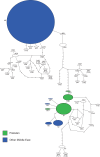Mitochondrial DNA Variation Among Populations of Rhynchophorus ferrugineus (Coleoptera: Curculionidae) From Pakistan
- PMID: 27651423
- PMCID: PMC5029037
- DOI: 10.1093/jisesa/iew065
Mitochondrial DNA Variation Among Populations of Rhynchophorus ferrugineus (Coleoptera: Curculionidae) From Pakistan
Abstract
The Red Palm Weevil (RPW) Rhynchophorus ferrugineus (Olivier) is a voracious pest of palm species. In recent decades its range has expanded greatly, particularly impacting the date palm industry in the Middle East. This has led to conjecture regarding the origins of invasive RPW populations. For example, in parts of the Middle East, RPW is commonly referred to as the "Pakistani weevil" in the belief that it originated there. We sought evidence to support or refute this belief. First reports of RPW in Pakistan were from the Punjab region in 1918, but it is unknown whether it is native or invasive there. We estimated genetic variation across five populations of RPW from two provinces of Pakistan, using sequences of the mitochondrial cytochrome oxidase subunit I gene. Four haplotypes were detected; two (H1 and H5) were abundant, accounting for 88% of specimens across the sampled populations, and were previously known from the Middle East. The remaining haplotypes (H51 and H52) were newly detected (in global terms) and there was no geographic overlap in their distribution within Pakistan. Levels of haplotype diversity were much lower than those previously recorded in accepted parts of the native range of RPW, suggesting that the weevil may be invasive in Pakistan. The affinity of Pakistani haplotypes to those reported from India (and the geographical proximity of the two countries), make the latter a likely "native" source. With regards the validity of the name "Pakistani weevil", we found little genetic evidence to justify it.
Keywords: COI; Khyber Pakhtunkhwa Province; Middle East; Pakistani weevil; Punjab Province.
© The Author 2016. Published by Oxford University Press on behalf of the Entomological Society of America.
Figures



Similar articles
-
The lesser of two weevils: molecular-genetics of pest palm weevil populations confirm Rhynchophorus vulneratus (Panzer 1798) as a valid species distinct from R. ferrugineus (Olivier 1790), and reveal the global extent of both.PLoS One. 2013 Oct 15;8(10):e78379. doi: 10.1371/journal.pone.0078379. eCollection 2013. PLoS One. 2013. PMID: 24143263 Free PMC article.
-
The First Report for the Presence of Spiroplasma and Rickettsia in Red Palm Weevil Rhynchophorus ferrugineus (Coleoptera: Curculionidae) in Egypt.Acta Parasitol. 2021 Jun;66(2):593-604. doi: 10.1007/s11686-020-00310-2. Epub 2021 Jan 3. Acta Parasitol. 2021. PMID: 33389546
-
Identification of the genes involved in odorant reception and detection in the palm weevil Rhynchophorus ferrugineus, an important quarantine pest, by antennal transcriptome analysis.BMC Genomics. 2016 Jan 22;17:69. doi: 10.1186/s12864-016-2362-6. BMC Genomics. 2016. PMID: 26800671 Free PMC article.
-
Omics in the Red Palm Weevil Rhynchophorus ferrugineus (Olivier) (Coleoptera: Curculionidae): A Bridge to the Pest.Insects. 2023 Mar 4;14(3):255. doi: 10.3390/insects14030255. Insects. 2023. PMID: 36975940 Free PMC article. Review.
-
Current Status of Biology-Biotechnic, Agronomic, and Biological Control of Rhynchophorus ferrugineus: A Review.Insects. 2024 Nov 30;15(12):955. doi: 10.3390/insects15120955. Insects. 2024. PMID: 39769557 Free PMC article. Review.
References
-
- Baloch H. B., Rustamani M. A., Khuhro R. D., Talpur M. A., Hussain T. 1992. Incidence and abundance of date palm weevil in different cultivars of date palm. Proc. Pak. Cong. Zool. 12: 445–447.
-
- Buxton P. A. 1920. Insect pests of dates and the date palm in Mesopotamia and elsewhere. Bull. Entomol. Res. 11: 287–304.
-
- Champion H. G., Seth S. K., Khattak G. M. 1960. Manual of silviculture for Pakistan. Pakistan Forest Institute, Peshawar.
-
- Clement M., Posada D., Crandall K. A. 2000. TCS: a computer program to estimate gene genealogies. Mol. Ecol. 9: 1657–1660. - PubMed
MeSH terms
Substances
LinkOut - more resources
Full Text Sources
Other Literature Sources

